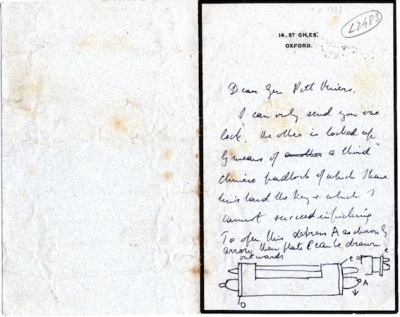To search the RPR site click here
S&SWM PR papers L2483
[This letter must have been written before November 1891 when Moseley died, however, the exact date is unknown and is not clear from the contents but is perhaps before 1883 when Primitive Locks was published by Pitt-Rivers? The locks referred to have not been identified but are / were presumably in the founding collection]
14, St Giles | Oxford
Dear Gen Pitt Rivers
I can only send you one lock the other is locked up by means of another a third Chinese padlock of which I have mislaid the key & which I cannot succeed in picking To open this depress A as [illegible] arrow then plate C can be drawn outwards this allows plate D at the other end to be turned round half a revolution and then the long plate at bottom of the lock can be slid out exposing the keyhole
In hast
HN Moseley
[Another sheet, it is not clear if it is related, it is presumably part of another letter dating from before 1883 when Primitive Locks was published (as this is part of Moseley's comments on it)]
Development of Primitive Locks and Keys
Line 6 Clou French a nail add ?? Clout English provincial a boot nail
Line 7 from bottom [illegible] "too late" from zero to put. The connection between these two words in which the quantity of the e is different is very uncertain. It is still more improbable that the connection if it must be through the meaning given namely "when the bar is put up. I have this from a very expert classic. It would probably be more judicious to omit reference to zero too late as such is not necessary to the argument.
page 4 line 9 from bottom after "Pad" Dutch a path insert ?Pfad German a path
Page 8 line 6 I cant make out the three tumblers in the plate referred to a word or two more of explanation in the text or explanation of the Plate might be of advantage
NB In the first two pages several additional connections as to Capital letters require to be made
Transcribed by AP for the Rethinking Pitt-Rivers project in July-August 2011




